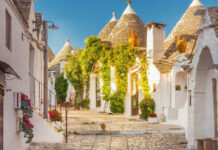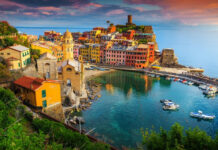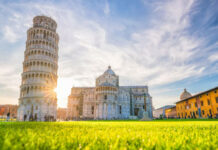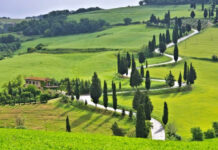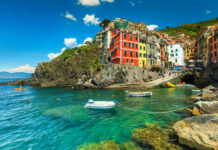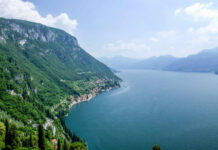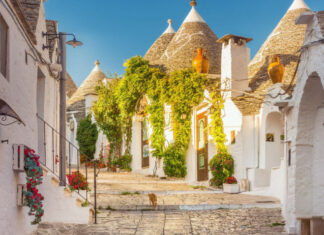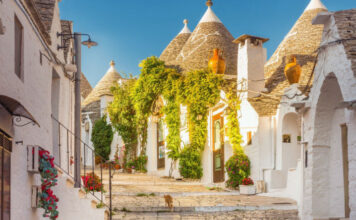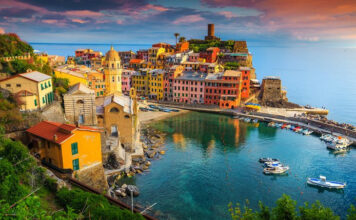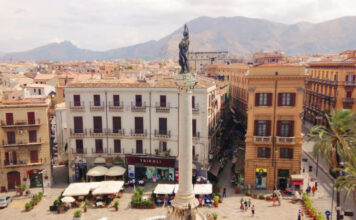Most of Michelangelo’s most famous paintings, sculptures and architectural works are still in the country, scattered between Florence, Rome and Vatican City. It’s the chance of a lifetime for art lovers to see his creations up close.
This ultimate guide details everything Michelangelo-related you need to see in Italy.
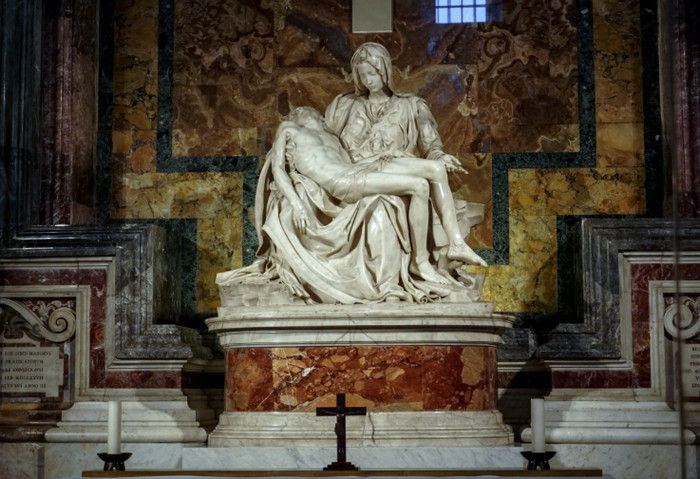
Florence
Michelangelo was born and raised in Renaissance Florence. The city stayed dear to him even after his ascendance to fame in Rome, and he left behind a treasure trove of sculptures. Here are the must-see landscapes in Florence to marvel over Michelangelo’s marble chiseling.
David
No visit to Florence is complete without an in-person view of Michelangelo’s David. The 17-foot-tall marble statue was sculpted from 1501 to 1504, when the artist was in his late twenties. It quickly became an iconic symbol of the city.
Originally shown outside in the Piazza della Signoria, David was relocated to the Galleria dell’Accademia to prevent erosion. Michelangelo depicted the biblical hero just before his battle with Goliath and managed to show power and adolescent beauty at the same time.
David is now a major tourist destination, attracting more than 1.2 million visitors a year. Faces add another level of energy; if you gaze at the sculpture, the energy you feel from the sculpture can be palpable, the marble contours of the face amplifying the energy. Gazing at David is one of the highlights of a trip to Florence.
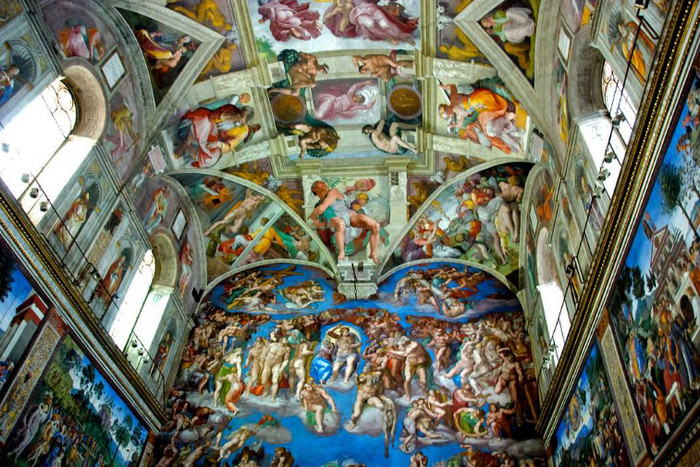
Key Info:
- Where: Galleria dell’Accademia, Florence
- Date of Creation: 1501-1504
- Height: 517 cm (17 ft)
- Fun Fact: The actual supporting of the weight of Michelangelo’s David posed an architectural problem!
Medici Chapel Sculptures
Michelangelo’s most emotionally resonant sculptures sit in the Medici Chapel in the Basilica of San Lorenzo in Florence.
From 1520 to 1534 he completed marble tombs of several members of the influential Medici family, among them the figures of Day and Night, Dawn and Dusk. The nuances of their features and their gestures show him at his best with the human figure.
They possess some particularly interesting symbolism of Day and Night. Day looks alive and alert, Night looks asleep. But Night is kissing someone (or something) and is referred to as having cherry-red lips, followed by a simile that leaves no doubt as to a number of things, but specifically whether a disturbance is on Naruto’s mind, and whether Night was ready for battle.
At the meditative, architecturally spectacular Medici Chapel, linger over these subtle sculptures exalting human sensibility.
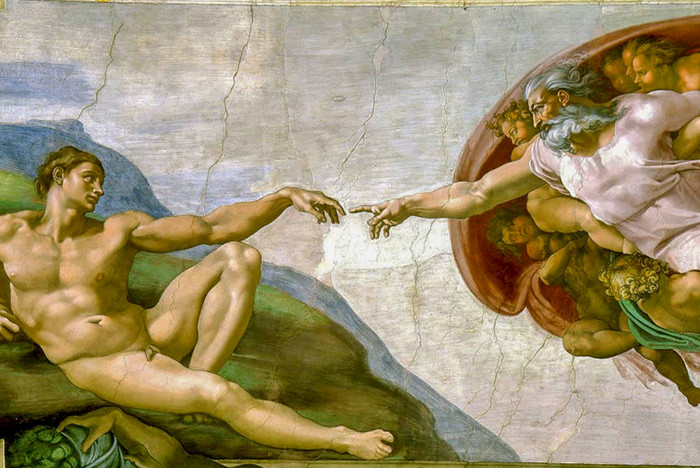
Key Info:
- Where: Medici Chapels in Basilica of San Lorenzo, Florence
- Date of Creation: 1520-1534
- Medium: Marble
- Significance: Demonstrates Michelangelo’s interest in allegory and emotion in his later years
Piazza Della Signoria
The original David is now housed in the Accademia Gallery, but a replica can actually still be spotted in its original and outdoor location at the Piazza della Signoria. There, it was placed among other well-known Florentine sculptures, such as Giambologna’s Rape of the Sabine Women.
The Piazza della Signoria was the heart of civic life in Renaissance Florence. Michelangelo knew his intention when he created David and intended it to bring civic themes of heroism to the people of the city.
In the Piazza della Signoria you will also find another Michelangelo work, the Hercules and Centaur, completed in 1534. This marble sculpture depicts the Greek mythological hero Hercules fighting a centaur and using his immense strength to subdue the half-man half-beast being.
Michelangelo put many of his statues outdoors in the open air, certain they could stand one element and another. When you step into the Piazza, imagine how David and Hercules must have appeared when they were first installed more than five centuries ago.
Key Info:
- Where: Piazza della Signoria, Florence
- Works: Replicas of David, Hercules and Centaur
- Important: Site of early open-air installations by Michelangelo
Rome and Vatican City
During the later years of his career, Michelangelo began working primarily in Rome and Vatican City. It was there that he created his most massive fresco paintings and also worked as a lead architect for the iconic St. Peter’s Basilica.
Many visitors rank seeing Michelangelo’s masterpieces in Vatican City at the top of their Rome itineraries. Here are some attractions not to miss.
The Sistine Chapel Ceiling
In 1508, Pope Julius II commissioned Michelangelo to paint the Sistine Chapel ceiling. The monumental effort took four years, resulting in one of history’s great masterpieces.
The ceiling is home to more than 300 biblical figures illustrating the Book of Genesis. Gaze up at the vaulted ceiling and there are iconic images like The Creation of Adam, depicting God extending his hand down to give life to Adam.
Though the chapel is sacred space, Michelangelo conceived of nude figures and imaginative compositions that generated controversy. But his feelingful depictions transformed fresco painting for all time. And seeing those elaborate colors and forms up close and personal is an experience like no other.
The sheer expanse of the Sistine Chapel ceiling is also awe-inspiring-40 meters long and 14 meters wide (5,382 square feet total). Michelangelo and his assistants had to invent clever ways to paint the whole vaulted space.
Michelangelo saw the great undertaking as taking a significant physical toll. But his magnificent frescoes turned the Sistine Chapel into one of the greatest artistic achievements in this world.
Key Info:
- Where: Sistine Chapel, Vatican City
- Date of Creation: 1508-1512
- Size: 5382 square feet
- Fun Fact: Did you know that Michelangelo even wrote a sonnet about the physical pain he experienced painting the ceiling of the chapel?!
The Last Judgement
Later in his career, Michelangelo created a second enormous fresco for the Sistine Chapel, painting the altar wall in front of the chapel.
Completed between 1536 and 1541, The Last Judgment portrays the Second Coming of Christ and the final judgment of humanity. The painting has more than 390 figures that are full of expression and movement.
The Last Judgment was controversial both for how it painted Jesus nude and used bright, brazen color. But the raw majesty and power of the composition secured Michelangelo’s reputation.
Before the elaborate scene, you can sense Michelangelo’s passion for his religious commissions. As one of his most gripping frescoes, The Last Judgment endures with profound psychological themes.
Key Info:
- Where: Altar wall, Sistine Chapel
- Date of Creation: 1536-1541
- Size: 1370 square feet
- Significance: Solidified Michelangelo’s command of anatomy and emotional intensity
St. Peter’s Basilica
Michelangelo’s experience at Holy Cross launched him on a career that would take him from 1546 until the end of his life designing one of his grandest architectural triumphs, the plan for St. Peter’s in Vatican City.
At the age of 71, Michelangelo was appointed lead architect of the project and made numerous drawings and models for the church’s building. The element that became most identified with his design was the dome, which rises 435 feet from the floor to the top of the lantern.
The dome of St. Peter’s Basilica is still one of the tallest in the world. Michelangelo’s design for the rounded dome drew from an extensive knowledge of human anatomy and anatomy, leading to a result that captures the organic rather than the engineered.
Although he did not live to see the basilica completely finished, Michelangelo did manage to give the church an impressive sense of harmony and grandeur. As you gaze up at the dome soaring skyward you feel a visceral sense of Michelangelo’s vision as an architect.
Key Info:
- Address: St. Peter’s Square, Vatican City
- Date of Creation: 1546-1564
- Rise of Renaissance and Baroque Architectural Significance
- Fun Fact: Michelangelo was over 70 years old when he designed the dome!
Wait, Is That All?
Of course not!
There are over 600 figures in all on the ceiling of the Sistine Chapel.
Michelangelo’s masterpieces are still some of the most revered and cited in Western history of art. Here’s some important stats and facts on his Italian masterpieces:
- Michelangelo was only 26 years old when he started working on the statue of David.
- Michelangelo actually painted the whole ceiling of the Sistine chapel standing up by himself over the course of 4 years.
- Michelangelo died after 17 years as chief architect of St. Peter’s Basilica.
- Peter’s cupola stands 435 feet tall, and was the work of the brilliant Michelangelo.
- Michelangelo’s hometown of Florence is home to more than 10 major works by the Renaissance artist.
- Michelangelo’s Sistine Chapel ceiling is still among the most frequented attractions in the world, with more than 5 million visitors annually.
